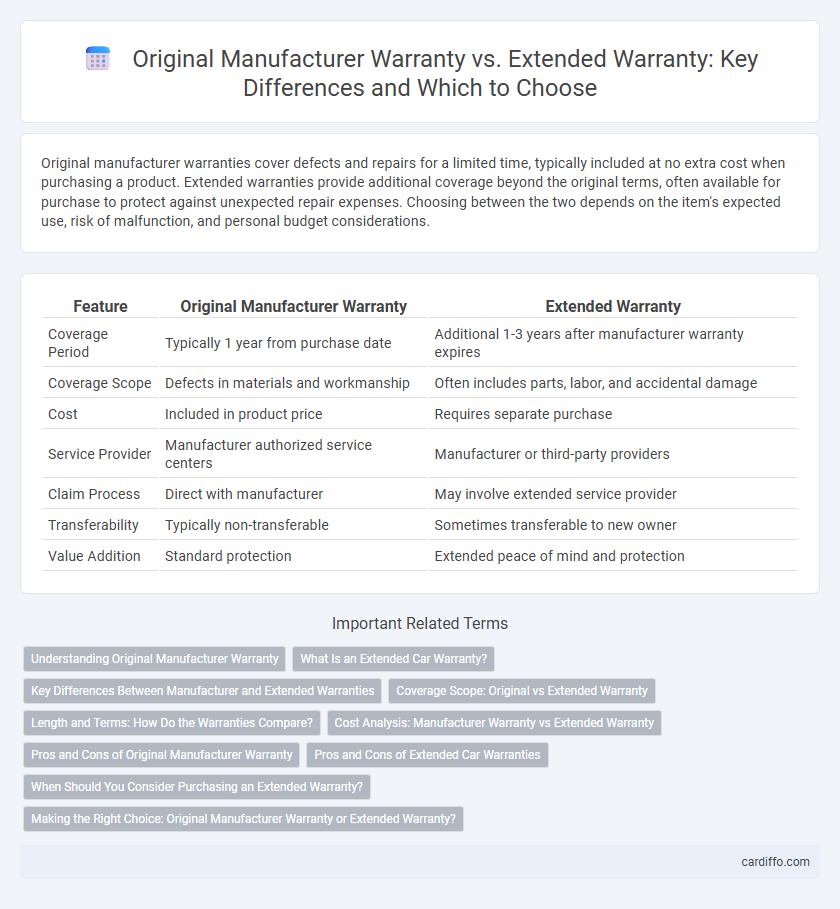Original manufacturer warranties cover defects and repairs for a limited time, typically included at no extra cost when purchasing a product. Extended warranties provide additional coverage beyond the original terms, often available for purchase to protect against unexpected repair expenses. Choosing between the two depends on the item's expected use, risk of malfunction, and personal budget considerations.
Table of Comparison
| Feature | Original Manufacturer Warranty | Extended Warranty |
|---|---|---|
| Coverage Period | Typically 1 year from purchase date | Additional 1-3 years after manufacturer warranty expires |
| Coverage Scope | Defects in materials and workmanship | Often includes parts, labor, and accidental damage |
| Cost | Included in product price | Requires separate purchase |
| Service Provider | Manufacturer authorized service centers | Manufacturer or third-party providers |
| Claim Process | Direct with manufacturer | May involve extended service provider |
| Transferability | Typically non-transferable | Sometimes transferable to new owner |
| Value Addition | Standard protection | Extended peace of mind and protection |
Understanding Original Manufacturer Warranty
The Original Manufacturer Warranty provides coverage directly from the product maker, typically including defects in materials and workmanship for a specified period, usually ranging from one to three years. This warranty ensures that repairs or replacements are performed by authorized service centers using genuine parts, maintaining product integrity and performance. Understanding the terms, limitations, and claim procedures of the Original Manufacturer Warranty helps consumers avoid unexpected costs and preserves the product's value.
What Is an Extended Car Warranty?
An extended car warranty is a service contract purchased separately from the original manufacturer warranty, providing coverage beyond the initial period or mileage limits. It covers repairs and maintenance for major components, offering protection against unexpected mechanical failures after the original warranty expires. This extended coverage ensures continued peace of mind and potential cost savings on vehicle repairs.
Key Differences Between Manufacturer and Extended Warranties
Original manufacturer warranties typically cover defects in materials and workmanship for a limited period, usually ranging from one to three years, with service and repairs performed by authorized dealers. Extended warranties provide prolonged coverage beyond the manufacturer's terms, often including additional protection such as accidental damage, wear and tear, or roadside assistance for an added cost. Key differences include the length of coverage, scope of protection, and who administers the service, with extended warranties offering broader coverage but often coming with exclusions and deductibles.
Coverage Scope: Original vs Extended Warranty
Original Manufacturer Warranty typically covers defects in materials and workmanship for a specified period, ensuring repair or replacement at no additional cost. Extended Warranty expands coverage beyond the original term, often including accidental damage, wear and tear, and more comprehensive repairs not covered under the manufacturer's plan. Consumers benefit from extended protection that mitigates unexpected expenses after the original warranty expires.
Length and Terms: How Do the Warranties Compare?
Original manufacturer warranties typically cover products for a standard period ranging from one to three years, providing repair or replacement for defects under specific conditions. Extended warranties extend this coverage beyond the original term, often including additional services like accidental damage protection and technical support, with terms varying widely by provider. Consumers should compare the length and specific conditions, such as coverage exclusions and claim processes, to determine which warranty best suits their needs.
Cost Analysis: Manufacturer Warranty vs Extended Warranty
Original manufacturer warranties typically cover repairs and replacements at no additional cost during the initial product lifespan, providing a cost-effective solution for early defects. Extended warranties require upfront or periodic payments and may offer coverage beyond the manufacturer's period, but often involve limitations and out-of-pocket expenses. Analyzing the total cost of ownership includes weighing the manufacturer's free coverage against extended warranty fees and potential repair costs outside the standard warranty period.
Pros and Cons of Original Manufacturer Warranty
Original Manufacturer Warranties provide reliable coverage backed directly by the product maker, ensuring authorized repairs and genuine parts, which often maintains the product's value. However, these warranties typically have limited duration and specific terms, leaving customers exposed to high repair costs once expired. While extended warranties offer prolonged protection, the original manufacturer warranty guarantees authenticity and may include comprehensive support during the initial period.
Pros and Cons of Extended Car Warranties
Extended car warranties provide additional coverage beyond the original manufacturer warranty, often including repairs for wear and tear or electrical components not covered by the manufacturer. They offer peace of mind and potential cost savings on expensive repairs but come with higher upfront costs and may have limitations or exclusions that reduce their overall value. Consumers should weigh the likelihood of future repairs and the warranty's terms against its price to determine if an extended warranty offers practical protection.
When Should You Consider Purchasing an Extended Warranty?
Consider purchasing an extended warranty when the original manufacturer warranty is limited in duration or coverage, especially for high-cost or complex products prone to repair expenses. Extended warranties offer prolonged protection beyond the standard period, reducing potential out-of-pocket repair or replacement costs. Evaluate the product's reliability, usage frequency, and repair costs to determine if extended coverage provides significant financial benefit.
Making the Right Choice: Original Manufacturer Warranty or Extended Warranty?
Choosing between the original manufacturer warranty and an extended warranty depends on product type, usage frequency, and risk tolerance. Original manufacturer warranties typically cover defects and repairs for a limited period, ensuring reliability with no additional cost. Extended warranties offer prolonged coverage beyond the original terms, providing peace of mind for higher repair expenses or longer product lifespans, especially for electronics and appliances.
Original Manufacturer Warranty vs Extended Warranty Infographic

 cardiffo.com
cardiffo.com